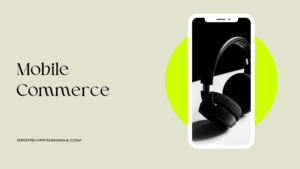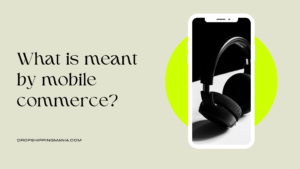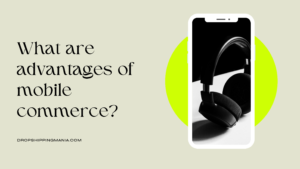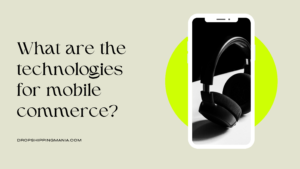Mobile Commerce

Mobile commerce (m- commerce) is the use of mobile devices to buy, sell and transfer goods or services. It has revolutionize the way business interact with their customers, as well as how customers shop for products and services. The increase prevalence of mobile phones has enabled a whole new way of shopping. One that is convenient, secure, and accessible from anywhere. In this blog post, we’ll take a look at what mobile commerce is and why it’s making such an impact on our lives today. We’ll also explore some key considerations for business looking to implement m -commerce solutions into their operations. Finally, we’ll touch on some of the challenges surrounding mobile commerce in order to help you gain a better understanding of the technology and its implications.
What is meant by mobile commerce?

Mobile commerce is the process of buying and selling goods and services via mobile devices such as smart phones and tablets. Mobile commerce has been growing in popularity in recent years. As more and more consumers are using their mobile devices to shop online.
There are a few different types of mobile commerce, including:
M- shopping: This is the process of buying goods and services online using a mobile device. Mobile shopping is convenient for consumers as they can shop anywhere and anytime.
Mobile banking: This is the process of manage one’s finances via a mobile device. M-banking is convenient for users as they can check their account balances, transfer funds, and pay bills on the go.
M- payments: This is the process of making payments using a mobile device. Mobile payments are convenient for consumers as they can make purchases without carrying cash or credit cards.
What are the 3 types of mobile commerce?

The three types of mobile commerce are m-commerce apps, mobile website, and contactless payments.
M-commerce apps are native applications that are download and install on a mobile device. Mobile web sites are web-base applications that are access through a mobile device web browser. Contactless payments are transactions that are made using a mobile device without the need for physical contact between the device and the point of sale terminal.
What are the features of mobile commerce?
There are many feature of mobile commerce, but some of the most important ones include:
-The ability to shop anywhere at any time: This is probably the most obvious and important feature of mobile commerce. With mobile commerce, shoppers can make purchase no matter where they are or what time it is. This is extremely convenient for shoppers and has led to a significant increase in sales for business that offer mobile commerce options.
-Increased personalization: Mobile commerce also offers business the opportunity to personalize the shopping experience for their customers. This can done in a number of ways, such as provide customize recommendations based on past purchase history or present different versions of the same product based on the shopper’s location.
-Greater engagement with customers: Mobile commerce provides businesses with a great way to engage with their customers. Businesses can use push notifications to send special offers or updates directly to their customer’s phones. They can also use GPS tracking to provide location base offers and coupons.
These are just a few of the many feature of mobile commerce. By offering these feature, business are able to provide a better shopping experience for their customers and increase sales.
What are advantages of mobile commerce?

Mobile commerce, also known as m -commerce or simply m-comm, is the process of conducting transactions using a mobile device. This can include buying and selling goods and services, transferring funds, paying bills, and more.
There are many advantages to mobile commerce for both business and consumers. For businesses, it offers a new sales channel and can help to reach new customers. It can also increase efficiency by allowing employees to conduct business transactions on the go. For consumers, mobile commerce offers convenience and 24/7 access to businesses. Additionally, it can provide deals and discounts that are not available through traditional channels.
Some of the key advantages of mobile commerce include:
Convenience: This commerce is convenient for both businesses and consumers. Consumers can shop and make purchases anytime, anywhere. Businesses can reach their customers no matter where they are.
Increased Sales: This commerce provides business with a new sales channel that can help to boost revenue. Additionally, m-commerce can help business to reach new customers who may not reached through traditional channels.
Efficiency: Mobile commerce can help business to increase efficiency by allowing employees to conduct transactions on the go. This can save time and money for business by eliminating the need for travel or face -to-face meetings.
Deals & Discounts: Mobile commerce offers consumers access to deals and discounts that are not available through traditional channels. This can entice customers to make purchases through their mobile devices instead
What are types of mobile commerce?
There are three types of mobile commerce: m- commerce, t- commerce, and c -commerce.
This is define as commerce conduct via a mobile device, such as a smart phone or tablet. This type of mobile commerce typical includes purchasing goods and services, as well as conducting financial transactions, such as making a payment or transfer money.
T-commerce is define as commerce conduct via a smart TV. This type of mobile commerce typical includes purchasing goods and services, as well conducting financial transactions, such as making a payment or transferring money.
C-commerce is defined as commerce conducted via a wear able device, such as a smart watch or fitness tracker. This type of this typical includes purchase goods and services. As well conducting financial transactions, such as making a payment or transferring money.
What is the future of m-commerce?

M-commerce, or mobile commerce, is the buying and selling of goods and services through this devices such as smart phones and tablets. M-commerce has been growing in popularity in recent years as more and more people use their mobile devices to shop online.
The future of m- commerce looks bright. In 2020, m-commerce sales are expecte to reach $2.32 trillion worldwide. This is a significant increase from the $1.3 trillion in sales that were generate in 2016. The growth of this can attribute to the increase number of people who own mobile devices and the expand capability of those devices.
What are the 4 main mobile marketing tools?
1. SMS Marketing: Short message service (SMS) marketing is a form of direct marketing that uses text messaging to promote products, services, or brands. SMS marketing can an effective way to reach out to mobile users, with nearly 98% of texts read within five minutes of being receive.
2. MMS Marketing: Multi media Messaging Service (MMS) marketing is a form of direct marketing that uses multi media messages to promote products, services, or brands. MMS messages can include text, images, videos, and audio files, making them a more engage option than SMS messages for many consumers.
3. Mobile App Marketing: Mobile app market is the process of promote a mobile app to reach potential users. The goal of mobile app marketing is to generate interest in the app and encourage downloads. There are a number of ways to market a mobile app, including through social media, paid advertising, and PR campaigns.
4. QR Code Marketing: QR code marketing is a type of direct marketing that uses QR codes (quick response codes) to promote products, services, or brands. This codes can scanned by mobile devices and link directly to web sites or other online content. This can be an effective way to reach out to mobile users and give them quick access to information about your company or product
What are the 4 models of e commerce?

The four models of ecommerce are business to – consumer (B2C), business -to- business (B2B), consumer-to- consumer (C2C), and consumer-to-business (C2B).
business to consumer (B2C): This occurs when a business sells products or services to consumers through an online plat form. This is the most common type of ecommerce, and examples include online retailer like Amazon and eBay.
business to business (B2B): This describes the exchange of goods or services between two business through an online plat form. A common example of B2B ecommerce is when a manufacturer sells products to a whole saler or retailer through an online market place.
consumer to consumer (C2C): This happens when consumers sell products or services to other consumers through an online plat form. The best example of a C2C market place is Craigslist, where people can buy and sell used goods locally.
consumer -to- business (C2B): In C2B ecommerce, consumers sell goods or services to business through an online plat form. An example of this would be if someone sold their hand made jewelry to a local boutique through an online market place like Etsy.
What are the technologies for mobile commerce?

The technology for mobile commerce are constantly evolving, but some of the most common include Near Field Communication (NFC), Bluetooth Low Energy (BLE), QR codes, and apps. NFC is a short -range wire less technology that allows two devices to communicate with each other when they are close together, typical no more than a few centi meters apart. BLE is a low power version of Bluetooth that is designed for use with small devices like wear able fitness trackers. QR codes are two dimensional barcode that can be read by smart phones and other mobile devices. They are often used to provide information or links to web sites or other online resources. Apps are specialized soft ware programs that can down load and install on mobile devices; many business have create apps to provide their customers with convenient access to their products and services.
If you don’t know about sell side ecommerce then visit this link


